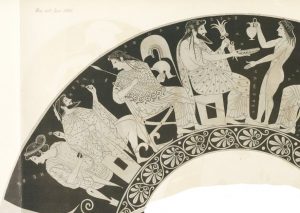Chapter 2: The Olympians
Previous Page Table of Contents Next Page
♠ Homer, Iliad 4.2-3
Now the gods, seated by the side of Zeus, were holding assembly on the golden floor, and in their midst the queenly Hebe poured them nectar. Greek Text
♠ Homer, Iliad 5.905
And Hebe bathed him, and clad him [Ares] in beautiful raiment. Greek Text
♠ Homer, Iliad 5.722
and Hebe quickly put to the car on either side the curved wheels of bronze, eight-spoked, about the iron axle-tree. Greek Text
♠ Homer, Odyssey 11.602-4
And after him I marked the mighty Heracles—his phantom; for he himself among the immortal gods takes his joy in the feast, and has to wife Hebe, of the fair ankles, daughter of great Zeus and of Here, of the golden sandals. Greek text
♠ Hesiod, Theogony 950-55
And mighty Heracles, the valiant son of neat-ankled Alcmena, when he had finished his grievous toils, made Hebe the child of great Zeus and goldshod Hera his shy wife in snowy Olympus. Happy he! For he has finished his great work and lives amongst the undying gods, untroubled and unaging all his days. Greek Text
♠ Hesiod, Ehoai (Catalogue of Women) fr 25.26-29 MW – Fragmenta Hesiodea, p. 16, ed. R. Merkelbach and M. L. West. Oxford 1967.
But now he is a god, and he has escaped all evils. And he lives in the same place as others having homes on Olympos, immortal and ageless, having fair-ankled Hebe, daughter of great Zeus and golden-sandaled Hera. (Transl. T. Gantz)
♠ Pindar, Nemean 7.4
Eleithuia, seated beside the deep-thinking Fates, hear me, creator of offspring, child of Hera great in strength. Without you we see neither the light nor the dark night before it is our lot to go to your sister, Hebe, with her lovely limbs. Greek Text
♦ London, British Museum 1971.11-1.1: Attic black-figure dinos by Sophilos, “The Erskine Dinos,” with Hebe between Dionysos and Cheiron

Perseus Art and Archaeology Artifact Browser
Beazley Archive Pottery Database
♦ Tarquinia, Museo Nazionale RC 6848: Attic red-figure cup by Oltos, assembly of gods with Hebe seated on far left

Monumenti inediti pubblicati dall’Instituto di corrispondenza archeologica 10 (1874-78), detail of pls. 23-4
Beazley Archive Pottery Database
♠ Homer, Iliad 11.269-72
And even as when the sharp dart striketh a woman in travail, the piercing dart that the Eilithyiae, the goddesses of childbirth, send—even the daughters of Hera that have in their keeping bitter pangs; even so sharp pains came upon the mighty son of Atreus. Greek Text
♠ Homer, Iliad 16.187-88
But when at length Eileithyia, goddess of child-birth, had brought him to the light, and he saw the rays of the sun. Greek Text
♠ Homer, Iliad 19.103-4
This day shall Eileithyia, the goddess of childbirth, bring to the light a man that shall be the lord of all them that dwell round about. Greek Text
♠ Homer, Iliad 19.117-19
This child Hera brought forth to the light even before the full tale of the months, but stayed Alcmene’s bearing, and held back the Eileithyiae. Greek Text
♠ Homer, Iliad 11.270
the piercing dart that the Eilithyiae, the goddesses of childbirth, send. Greek Text
♠ Homer, Iliad 19.117-19
This child Hera brought forth to the light even before the full tale of the months, but stayed Alcmene’s bearing, and held back the Eileithyiae. Greek Text
♠ Homer, Iliad 11.269-72
And even as when the sharp dart striketh a woman in travail, the piercing dart that the Eilithyiae, the goddesses of childbirth, send—even the daughters of Hera that have in their keeping bitter pangs; even so sharp pains came upon the mighty son of Atreus. Greek Text
Previous Page Table of Contents Next Page
Tags:
Artistic sources edited by Frances Van Keuren, Prof. Emerita, Lamar Dodd School of Art, Univ. of Georgia, July 2018.
Literary sources edited by Elena Bianchelli, Retired Senior Lecturer of Classical Languages and Culture, Univ. of Georgia, January 2021
1,092 total views, 3 views today